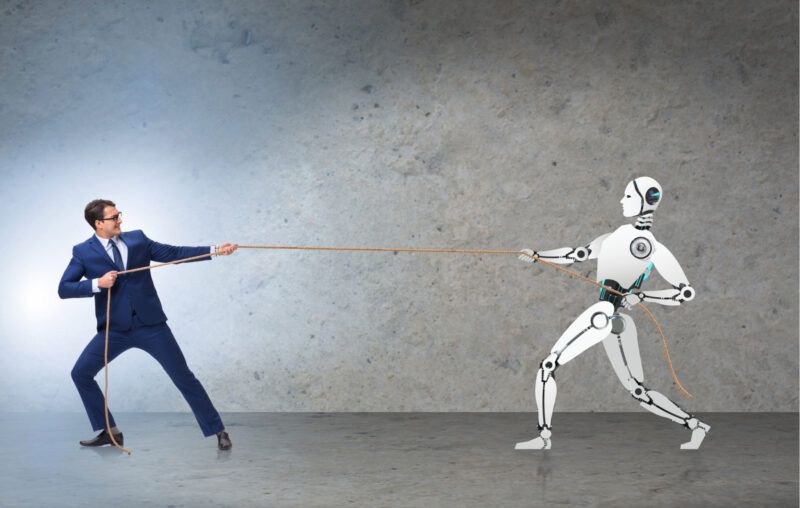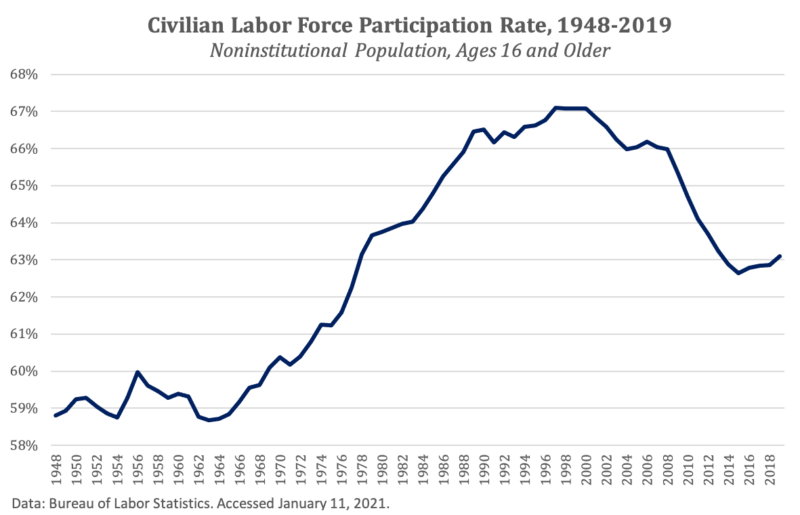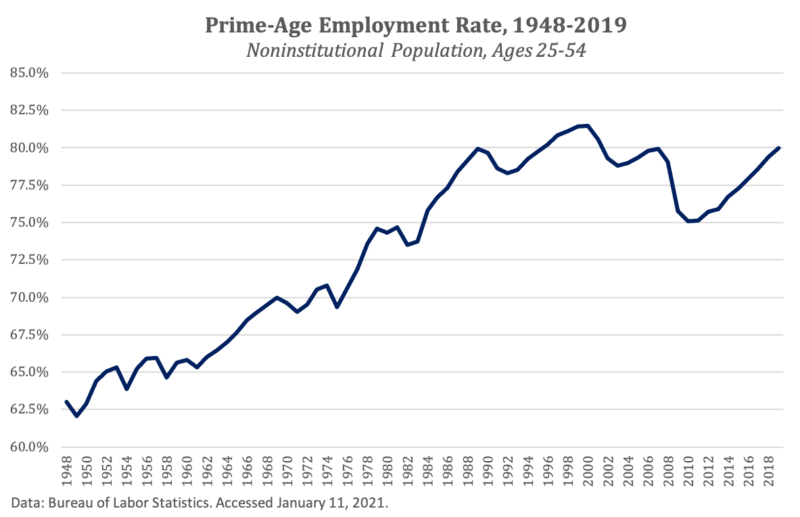A Pro-UBI Talking Point Debunked

Back in 2013, the Washington Post ran the headline: “Thinking Utopian: How About a Universal Basic Income [UBI]?” The article was written as a thought experiment; it concluded that while a UBI may be worth pursuing in the future, “right now doesn’t seem like the ideal time for Utopian thinking.”
But just eight years later, UBI – the proposition that all Americans should receive an unconditional cash transfer from the government – has gone mainstream. Unfortunately, so too have its bad talking points.
Proponents often frame UBI as a response to automation, suggesting that universal government handouts will become necessary in a world without work. They may be right. But many UBI advocates have gone beyond this futuristic argument, claiming instead that we’re already living in a work-barren country.
To advance this argument, proponents have often cited the economy’s low labor force participation rate (LFPR). Andrew Yang, the first presidential candidate to push for a UBI, used this talking point a number of times, including in a 2018 interview on the Ezra Klein Show:
“Our labor force participation rate started dropping as soon as we started getting rid of manufacturing workers in large numbers. Whereas we’re talking today, the labor force participation rate is 62.9 percent, which is a multi-decade low” (19:40-19:54).
This argument is technically true, yet highly misleading. To see why, there are two facts we need to know about the LFPR.
First, the LFPR is not a measure of employment. The LFPR calculates the sum of employed and unemployed individuals as a share of the population. Americans are counted as employed if they have a job; as unemployed if they are out of work, want to work, are available to work now, and have searched for work in the past four weeks; and as not in the labor force if they are out of work and don’t match the aforementioned criteria for being counted as unemployed.
This means that a high LFPR is possible even in the face of low employment. For example, a society in which 40 percent of the population was employed and 40 percent was unemployed would boast a LFPR of 80 percent. Ironically, it would have the same LFPR as a society in which 75 percent of the population was employed and only 5 percent was unemployed. So by itself, the LFPR tells us nothing about employment, joblessness, or the general strength of the labor market.
Second, the official LFPR doesn’t account for the aging of the population; it includes all Americans ages 16 and older. If a growing share of the population hits retirement age and chooses to stop working, the LFPR will fall even if job prospects haven’t worsened for most working-age people.
If you were oblivious to these points, you would look at the LFPR and conclude that the labor market has weakened in recent decades. From 1948-1968, the LFPR stayed just under 60 percent; it broke that threshold in 1969 and eventually peaked at 67.1 percent from 1997-2000. It then fell precipitously during the 2001 and 2008-2009 recessions, and had returned to its historical average of 62.9 percent when Yang gave his interview. (I exclude 2020 from the graph below in order to get a sense of the pre-Covid strength of the labor market. Yang gave his interview in 2018.)

The prime-age employment rate – the share of 25-54 year-olds with a job – tells a different story. By this metric, the pre-Covid labor market was hardly lacking for jobs. In 2019, the prime-age employment rate was 80.0 percent – the seventh-highest rate in American history, surpassed only by the six-year window ranging from 1996-2001. (Ironically for UBI supporters fretting about technological job displacement, the strongest labor market in U.S. history coincided with rising productivity and a huge boom in technology.) The employment rate of Americans in their prime working years has ranged from 62.1 percent in 1949 to 81.5 percent in 2000; yet as the graph below shows, employment was just below its all-time peak before Covid hit.

Granted, there is still a problem of declining employment among prime-age men. As Yang correctly pointed out in his interview, manufacturing jobs have gradually been disappearing in recent decades. Manufacturing peaked as a share of total employment in 1943 and in absolute terms in 1979. The subsequent decline has done immense harm to the affected male workers: Roughly half of prime-age men not in the labor force take daily pain medication, and many report a loss of meaning and purpose in their lives.
But this is a far more concentrated problem than a fictitious economy-wide plunge in employment. Since the Bureau of Labor Statistics began tracking employment data in 1948, the prime-age employment rate has declined 7.6 percentage-points for men, yet has risen 39.9 percentage points for women. Similarly, since manufacturing employment peaked in absolute terms in 1979, the male prime-age employment rate has fallen 4.7 percentage points, while the female rate has increased 14.6 percentage points – nearly three times as much.
Perhaps the robot apocalypse really will come at some point. Perhaps not. But what is clear is that it hasn’t come yet. Until it does, we should target our aid to Americans in need – not to the entire population.










